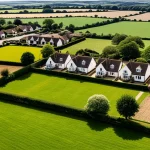Effects of Pet Ownership on UK Wildlife
Pet ownership impact on wildlife in the UK is increasingly significant, especially regarding the interaction between cats, dogs, and native species. Domestic cats, often allowed outdoors, are natural hunters and can directly reduce populations of birds, small mammals, and reptiles. This predation disrupts local ecosystems, particularly when cats target vulnerable or declining UK native species. Dogs, while less often hunting, pose a different challenge: their presence and activity can disturb sensitive wildlife through noise and physical intrusion.
The primary threats posed by domestic pets to local wildlife extend beyond predation. For example, pets roaming near nesting sites interrupt breeding behaviors, causing stress or nest abandonment among ground-nesting birds and other species. Such disturbances can lead to significant declines in wildlife reproductive success, especially in habitats that are already fragile or protected. The impact magnifies when pets roam freely in or near wildlife reserves, nature parks, or other ecologically sensitive areas.
Topic to read : How Can Owning a Pet in the UK Improve Your Everyday Life?
The significance of pet presence near sensitive habitats cannot be overstated. Wildlife experts emphasize that even well-intentioned pet owners must recognize the broader ecological footprint their animals create. Sustainable pet ownership involves mitigating the risk of negative interactions through strategies like leash control, contained outdoor spaces, and limiting access to vulnerable zones. The pet ownership impact on wildlife thus reflects a complex balance between allowing pets’ natural behaviors and conserving the rich biodiversity integral to many UK environments.
Predation by Domestic Cats and Dogs
Domestic cats exert a substantial cat predation UK impact on native wildlife, particularly targeting birds, small mammals, and reptiles. Research indicates that cats kill millions of individual animals annually across the UK, significantly affecting populations of vulnerable UK native species such as hedgehogs and songbirds. This predation disrupts food webs and can contribute to declines in species already facing habitat pressures. The stealth and hunting efficiency of domestic cats make them formidable predators despite their small size, especially when allowed to roam freely outdoors.
This might interest you : How Does the Popularity of Exotic Pets Affect Local Ecosystems in the UK?
Off-leash dogs, while less inclined to hunt, cause dog wildlife disturbance through direct interference with ground-nesting birds and small animals. When dogs enter sensitive areas during breeding seasons, their presence causes stress, nest abandonment, and occasionally direct harm to wildlife. Studies show that disturbance by dogs can reduce breeding success—an effect that compounds the challenges faced by UK native species striving to reproduce in fragmented habitats.
UK-based ecological research provides solid evidence on the scale and nature of domestic pets hunting wildlife. For example, longitudinal studies in rural and suburban zones have quantified bird predation rates attributable to cats, highlighting the disproportionate impact in areas where natural predators are scarce. Similarly, conservationists document frequent disruptions caused by dogs in wildlife reserves, emphasizing the need for stricter controls during critical breeding periods. These findings underscore the broad consequences of unchecked predation and disturbance stemming from common pet behaviors and point towards the necessity of managing pet and wildlife interaction carefully to protect biodiversity.
Disease Transmission from Pets to Wildlife
Disease transmission in wildlife from domestic pets presents a significant but often underappreciated threat to UK native species. Pet-borne diseases such as toxoplasmosis and canine parvovirus are among the most concerning illnesses transferred from domestic animals to wildlife populations. Toxoplasmosis, caused by the parasite Toxoplasma gondii, is particularly linked to domestic cats, which shed infectious oocysts in their feces. Wildlife species, especially small mammals and birds, can become infected when they come into contact with contaminated environments, affecting their survival and reproductive success.
In addition to toxoplasmosis, disease transmission in wildlife includes viral, bacterial, and parasitic infections passed from both cats and dogs. Canine distemper and parvovirus have been documented to affect wild carnivores in the UK, illustrating how pet diseases can spill over and impact native animal health. Furthermore, some infections have zoonotic potential, posing risks not only to animals but also to humans, complicating disease management efforts.
Veterinary and conservation organizations in the UK increasingly emphasize the need to control pet roaming and improve vaccination coverage to reduce the spread of infections. Recommendations include keeping cats indoors or in enclosed outdoor spaces, routine vaccination of pets, and discouraging free-roaming behavior, particularly near sensitive habitats. These measures help minimize pet and wildlife interaction that facilitates disease transfer, protecting vulnerable UK native species from additional health stresses linked to pet ownership impacts on wildlife.
Habitat Disturbance and Environmental Impact
Pet ownership impact on wildlife in the UK extends beyond direct predation to significant habitat disturbance UK. Free-roaming pets, particularly cats and dogs, disrupt local wildlife habitats by interfering with crucial behaviors such as nesting, denning, and foraging. For example, dogs off-leash often enter sensitive areas like ground-nesting bird sites, causing frequent stress responses and nest abandonment. This disruption diminishes breeding success and can reduce population viability for vulnerable UK native species.
The pet roaming effects also contribute to environmental degradation. Pets may trample vegetation and compact soil, altering microhabitats essential for invertebrates and plant regeneration. When pets access protected areas or designated wildlife reserves, their presence can lead to cumulative disturbance, undermining conservation efforts. The damage becomes especially pronounced in habitats already fragmented by urbanization and agricultural use, magnifying ecological consequences.
Illustrative cases reveal how pet activity changes local wildlife habitats. Studies document reductions in small mammal abundance in areas heavily visited by roaming cats, correlating with shifts in predator-prey dynamics. Similarly, dog activity near wetlands disrupts amphibian breeding sites by increasing water turbidity and physical disturbance of egg masses. Such examples underscore the complex and far-reaching environmental effects of pet and wildlife interaction, emphasizing the necessity for measures to control pet access to sensitive habitats.




